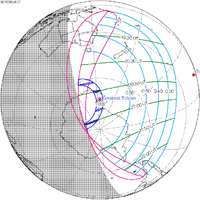| Partial eclipse | |||||||||||||
 The Moon's hourly motion shown right to left The Moon's hourly motion shown right to left | |||||||||||||
| Date | October 28, 1939 | ||||||||||||
|---|---|---|---|---|---|---|---|---|---|---|---|---|---|
| Gamma | −0.4581 | ||||||||||||
| Magnitude | 0.9876 | ||||||||||||
| Saros cycle | 135 (19 of 71) | ||||||||||||
| Partiality | 203 minutes, 22 seconds | ||||||||||||
| Penumbral | 346 minutes, 5 seconds | ||||||||||||
| |||||||||||||
| ← May 1939March 1940 → | |||||||||||||
A partial lunar eclipse occurred at the Moon’s descending node of orbit on Saturday, October 28, 1939, with an umbral magnitude of 0.9876. A lunar eclipse occurs when the Moon moves into the Earth's shadow, causing the Moon to be darkened. A partial lunar eclipse occurs when one part of the Moon is in the Earth's umbra, while the other part is in the Earth's penumbra. Unlike a solar eclipse, which can only be viewed from a relatively small area of the world, a lunar eclipse may be viewed from anywhere on the night side of Earth. Occurring about 5.3 days after apogee (on October 23, 1939, at 0:05 UTC), the Moon's apparent diameter was smaller.
This lunar eclipse was the last of an almost tetrad, with the others being on May 14, 1938 (total); November 7, 1938 (total); and May 3, 1939 (total).
This was the last partial lunar eclipse of the first set of partial eclipses in Lunar Saros 135 as well as the largest partial lunar eclipse of the 20th century.
Visibility
The eclipse was completely visible over North America and western South America, seen rising over northeast Asia and eastern Australia and setting over eastern South America, west and central Africa, and Europe.
 
|
Eclipse details
Shown below is a table displaying details about this particular solar eclipse. It describes various parameters pertaining to this eclipse.
| Parameter | Value |
|---|---|
| Penumbral Magnitude | 2.04769 |
| Umbral Magnitude | 0.98764 |
| Gamma | −0.45812 |
| Sun Right Ascension | 14h06m46.1s |
| Sun Declination | -12°50'04.8" |
| Sun Semi-Diameter | 16'05.9" |
| Sun Equatorial Horizontal Parallax | 08.9" |
| Moon Right Ascension | 02h07m11.5s |
| Moon Declination | +12°25'18.8" |
| Moon Semi-Diameter | 15'11.2" |
| Moon Equatorial Horizontal Parallax | 0°55'44.2" |
| ΔT | 24.4 s |
Eclipse season
See also: Eclipse cycleThis eclipse is part of an eclipse season, a period, roughly every six months, when eclipses occur. Only two (or occasionally three) eclipse seasons occur each year, and each season lasts about 35 days and repeats just short of six months (173 days) later; thus two full eclipse seasons always occur each year. Either two or three eclipses happen each eclipse season. In the sequence below, each eclipse is separated by a fortnight.
| October 12 Ascending node (new moon) |
October 28 Descending node (full moon) |
|---|---|
 |

|
| Total solar eclipse Solar Saros 123 |
Partial lunar eclipse Lunar Saros 135 |
Related eclipses
Eclipses in 1939
- An annular solar eclipse on April 19.
- A total lunar eclipse on May 3.
- A total solar eclipse on October 12.
- A partial lunar eclipse on October 28.
Metonic
- Preceded by: Lunar eclipse of January 8, 1936
- Followed by: Lunar eclipse of August 15, 1943
Tzolkinex
- Preceded by: Lunar eclipse of September 14, 1932
- Followed by: Lunar eclipse of December 8, 1946
Half-Saros
- Preceded by: Solar eclipse of October 21, 1930
- Followed by: Solar eclipse of November 1, 1948
Tritos
- Preceded by: Lunar eclipse of November 27, 1928
- Followed by: Lunar eclipse of September 26, 1950
Lunar Saros 135
- Preceded by: Lunar eclipse of October 16, 1921
- Followed by: Lunar eclipse of November 7, 1957
Inex
- Preceded by: Lunar eclipse of November 17, 1910
- Followed by: Lunar eclipse of October 6, 1968
Triad
- Preceded by: Lunar eclipse of December 26, 1852
- Followed by: Lunar eclipse of August 28, 2026
Lunar eclipses of 1937–1940
| Ascending node | Descending node | |||||
|---|---|---|---|---|---|---|
| Saros | Date viewing |
Type chart |
Saros | Date viewing |
Type chart | |
| 110 | 1937 May 25
|
Penumbral
|
115 | 1937 Nov 18
|
Partial
| |
| 120 | 1938 May 14
|
Total
|
125 | 1938 Nov 07
|
Total
| |
| 130 | 1939 May 03
|
Total
|
135 | 1939 Oct 28
|
Partial
| |
| 140 | 1940 Apr 22
|
Penumbral
|
145 | 1940 Oct 16
|
Penumbral
| |
Saros 135
It was part of Saros series 135.
Half-Saros cycle
A lunar eclipse will be preceded and followed by solar eclipses by 9 years and 5.5 days (a half saros). This lunar eclipse is related to two total solar eclipses of Solar Saros 142.
| October 21, 1930 | November 1, 1948 |
|---|---|

|

|
See also
Notes
- "October 27–28, 1939 Partial Lunar Eclipse". timeanddate. Retrieved 18 December 2024.
- "Moon Distances for London, United Kingdom, England". timeanddate. Retrieved 18 December 2024.
- "Partial Lunar Eclipse of 1939 Oct 28" (PDF). NASA. Retrieved 18 December 2024.
- "Partial Lunar Eclipse of 1939 Oct 28". EclipseWise.com. Retrieved 18 December 2024.
- Mathematical Astronomy Morsels, Jean Meeus, p.110, Chapter 18, The half-saros
External links
- 1939 Oct 28 chart Eclipse Predictions by Fred Espenak, NASA/GSFC
This lunar eclipse-related article is a stub. You can help Misplaced Pages by expanding it. |


